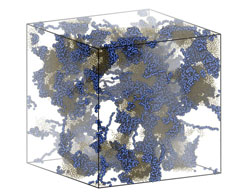
Graphic Processor Units for Many-particle Dynamics
.
- HomeReturn Home
- AboutWhat Do We Do
- HistoryOur Development Story
- PublicationsOur Scientific Published Works
- Our PeopleOur Development Team
- NewsRecent Activities
- GallerySamples of our work
- OtherHelpful Files
- You are here:
- Home >
- Other >
- Teacher Assistant >
- Engineering Drawing I
Non-Linear Finite Element Method

This course describes, besides the physical and mathematical background of the finite element method, special discretization techniques and algorithms which have to be applied for nonlinear problems of solid mechanics.
The course will describe the theory and computer implementation of nonlinear finite element method. The implementation will be carried out on simple heat transfer and solid mechanics problems.
The focus is on geometric nonlinearities; however some material nonlinearity will also be discussed. Both static and transient (time-dependent) problems will be studied.
The main textbook of the course is the book “An Introduction to nonlinear finite element analysis” by J.N. Reddy. The book is suitable as a text book for a first course as nonlinear finite elements in mechanical, civil, aerospace engineering departments.
Syllabus
|
|
Prerequisites:
- Finite Element I
- Continuum Mechanics
Visitors Counter
© 2009-2025 by GPIUTMD
We have 30 guests and no members online
Latest News
$150,000 AWARD FOR RESEARCHERS, UNIVERSITIES WORLDWIDE
NVIDIA is calling on global researchers to submit their innovations for the NVIDIA Global Impact Award - an annual grant of $150,000 for groundbreaking work that addresses the world's most important social and humanitarian problems.
Read more ...Unified Memory in CUDA 6
With CUDA 6, we’re introducing one of the most dramatic programming model improvements in the history of the CUDA platform, Unified Memory. In a typical PC or cluster node today, the memories of the CPU and GPU are physically distinct and separated by the PCI-Express bus. Before CUDA 6, that is exactly how the programmer has to view things. Data that is shared between the CPU and GPU must be allocated in both memories, and explicitly copied between them by the program. This adds a lot of complexity to CUDA programs.
Read more ...My Apple Style Countdown
© 2009-2015 by GPIUTMD
Word Cloud
![]() Copyright © 2014. GPIUTMD - Graphic Processor Units for Many-particle Dynamics
Copyright © 2014. GPIUTMD - Graphic Processor Units for Many-particle Dynamics
Isfahan University of Technology
Address: Esteghlal Sq., Isfahan, Iran
Postal Code: 8415683111
Phone: +98 311 391 3110
Fax: +98 311 391 2718
